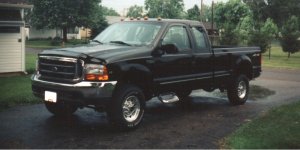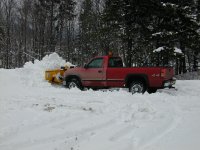Scott,
I agree with your conclusion that you need a longer trailer.
On the other hand you may or may not need to "center" the tractor over trailer wheels. The whole idea is that the center of gravity of the combined weight of the trailer and its load should be a little in front of the center of the wheel pattern of the trailer wheels. This puts some down force on the hitch ball and as others have noted it should typically be around 10 - 15% of the total weight of the trailer and its load. You could actually weigh the tongue weight on a platform scale, but in practice what you do is to look at the hitch ball as you are driving the tractor onto the trailer. As you are partially loaded, the hitch will be trying to pick the back of your truck up. Continuing forward with the tractor you will eventually see the tongue start to move downward. Once it is starting down it is a trial and error process to determine just how far to go. The trailer will be stable in towing as long as there is a downward force on the tongue. However, if you get too much down force the front of your truck will become light creating another steering and stability problem. This calls for installation of an "equalizing hitch" prior to loading the trailer.
It consists of two bars under tension between the truck and the trailer on either side of the ball. The pretensioning in the bars creates a torque that tries to raise the back of the truck and the front of the trailer when the load is not on the trailer. Then when you drive the load onto the trailer and increase the downforce on the hitch ball, the pre-torque in the opposite direction works to keep the trailer and the truck chassis as level as it can. One of the most common suppliers of this type of hitch is a company named Reese, and many people refer to the generic equalizing hitch by calling it a "Reese Hitch."
My trailer is 18 feet long and has tandem axles. I could not possibly tow it loaded with my tractor and equipment without having the equalizer hitch installed. Depending on what implements and attachments are being hauled with the tractor, the final position of the tractor itself relative to the center of the trailer wheel pattern will vary in order to get enough tongue weight.

